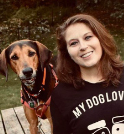Separation anxiety can exist in pets at no fault of the owner. If a dog has a history of being abandoned, rehomed, or experienced the death of an owner they may feel unsure of whether or not their owner will return.
On the other hand, things like moving, a family member moving out or going to college, or an owner returning to the office after working remotely can trigger separation anxiety in dogs.
It is important to make your pet sitter aware of separation anxiety in your pet whether they're coming to your house or if you’re boarding your dog at their location. Share as many details about your pet’s daily routine as possible; the ability to mimic your usual routine can help comfort your pet while you’re away.
Knowing the signs of separation anxiety can help you define the issue and find a solution that will work for you and your furry family member. Some signs of separation anxiety are:
- Persistent howling, crying or barking
- Drooling, specifically when you're gone or leaving the home
- Pacing around and not settling down
- Not eating while you're away
- Destructive habits like chewing furniture, window sills, door trims, getting into the trash, or destroying other items in the home
- Potty accidents while you're away
Potty trained dogs may start using the bathroom inside when you leave. Many owners laugh and say "He's mad because I left." This way of thinking isn't beneficial for your dog and the problem shouldn't be laughed off. It is important not to punish them when you return, this will only deepen their fear and anxiety. Be sure to bring your dog out before leaving, even reward them for using the bathroom outside. *It is important to rule out any medical concerns around these behaviors by talking to your vet. If all signs point to separation anxiety, you will need to find tools and training to help your pup.
You will want to make sure your dog is getting adequate exercise as well as mental stimulation. Daily walks are so important for dogs; taking one walk of at least a mile each day will help you and your dog get fresh air and exercise. Walks also allow your dog to explore their surroundings and take in sights and smells that they wouldn't get to experience in their own yard or home.
It is important to help desensitize your dog to triggers that indicate you are leaving. For example, practice putting your coat on or picking up your keys without leaving, over time these actions will become normal to your dog.
You can also leave food puzzles, snuffle mats, lick mats, stuffed kongs and other toys when you’re leaving. (hint: freeze lick mats and stuffed kongs or try a pupsicle to keep your dog busy longer) Keeping your dog busy and engaged may help stimulate their mind, distracting them from the fact that they’re home alone and help them settle down. Giving these kinds of treats and toys only when you are leaving may help your dog feel excited for your departure. It’s important to find what tool will work best for you and your furry best friend. Be sure not to leave any toys that may be ingested or cause choking, if your dog has a habit of ingesting pieces of toys or other items that may cause an obstruction or other injury you should speak to your vet before choosing to leave toys within your dog's reach when you're away.
If food and enrichment activities don’t help your anxious pup, crate training or keeping them in a specific room or area of the house may help reduce destruction and risk of your dog harming themselves. Reserve a safe space for your dog to occupy while you’re away, including toys, treat dispensers, a comfy dog bed and maybe even some soft music (we like to use our Amazon Alexa to play classical music and it even allows us to "drop in" with the camera feature!)
Proper crate training will help your dog to feel safe and secure in their crate, it is not recommended to use a crate for punishment. If your dog is not used to being in the crate, we do not recommend putting them in a crate for extended periods. This should be built up over time. Practice, first, while you are at home, then while you're away for short periods of time. Some dogs may try to chew their way out of a crate which can cause damage to their teeth or other injury.
Be patient with your furry family member and remember that punishment and intensity wouldn't help a human with anxiety and it won’t help a dog with anxiety either. Always consult a trainer and your vet for the best advice and information about your specific needs.
***Our blog posts may contain affiliate links which may pay a commission when a purchase is made through the links. We share tools, toys, treats and other items we have actually used and enjoyed.




